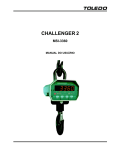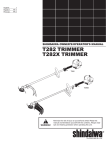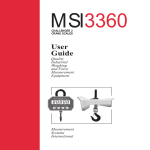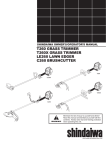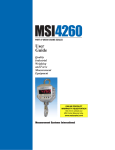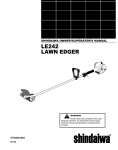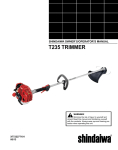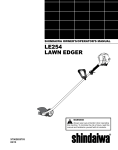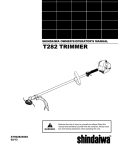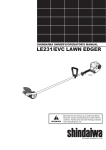Download Shindaiwa LE-250 Operator`s manual
Transcript
ENGLISH SHINDAIWA OWNER’S/OPERATOR’S MANUAL LE261/EVC LAWN EDGER LE261 WARNING! Minimize the risk of injury to yourself and others! Read this manual and familiarize yourself with the contents. Always wear eye and hearing protection when operating this unit. ® Part Number 62721-94310 Rev. 11/06 Introduction Attention Statements General Safety Instructions The Shindaiwa 261-series of hand-held power tools has been designed and built to deliver superior performance and reliability without compromise to quality, comfort, safety or durability. Throughout this manual are special “Attention Statements”. Work Safely Shindaiwa’s high-performance engines represent the leading edge of 2-cycle engine technology, delivering exceptionally high power with remarkably low displacement and weight. As an owner/operator, you’ll soon discover for yourself why Shindaiwa is simply in a class by itself! IMPORTANT! The information contained in these instructions describe product available at the time of publication. Shindaiwa Inc. reserves the right to make changes to products without prior notice, and without obligation to make alterations to units previously manufactured. Contents PAGE Attention Statements....................................2 General Safety Instructions.........................2 Safety Labels..................................................4 WARNING! A statement preceded by the triangular attention symbol and the word “WARNING” contains information that should be acted upon to prevent serious bodily injury. CAUTION! A statement preceded by the word “CAUTION” contains information that should be acted upon to prevent mechanical damage. IMPORTANT! A statement preceded by the word “IMPORTANT” is one that possesses special significance. NOTE: A statement preceded by the word “NOTE” contains information that is handy to know and may make your job easier. Read and follow this operators manual. Failure to do so could result in serious injury. Product Description......................................5 Specifications.................................................5 Assembly........................................................6 Wear eye and hearing protection at all times during the operation of this unit. Mixing Fuel...................................................8 Starting the Engine.......................................9 Stopping the Engine.....................................9 Engine Idle Adjustment..............................10 50 FEET (15m) Keep bystanders at least 50 feet (15 m) away during operation. Checking Unit Condition...........................10 Edging with a Hand-held Edger................10 Maintenance................................................11 Beware of thrown or ricocheted objects. Long Term Storage.....................................14 Troubleshooting Guide..............................15 Emission System Warranty........................17 Keep feet away from blade. Rotating blade may cause injury. IMPORTANT! The operational procedures described in this manual are intended to help you get the most from your 261 Edger as well as to protect you and others from harm. These procedures are guidelines for safe operation under most conditions, and are not intended to replace any safety rules and/or laws that may be in force in your area. If you have questions regarding your 261 Edger unit, or if you do not understand something in this manual, your Shindaiwa dealer will be glad to assist you. You may also contact Shindaiwa, Inc. at the address printed on the back of this Manual. Edgers operate at very high speeds and can do serious damage or injury if they are misused or abused. Never allow a person without training or instruction to operate your 261 Edger! WARNING! Never make unauthorized attachment installations, nor use attachments not approved by Shindaiwa for use on this unit. WARNING! Never operate power equipment of any kind if you are tired or if you are under the influence of alcohol, drugs, medication or any other substance that could affect your ability or judgement. WARNING! Minimize the Risk of Fire! NEVER smoke or light fires near the edger. ALWAYS stop the engine and allow it to cool before refueling. Avoid overfilling and wipe off any fuel that may have spilled. ALWAYS move the unit to a place well away from a fuel storage area or other readily flammable materials before starting the engine. NEVER place flammable material close to the engine muffler. NEVER run the engine without the spark arrester screen in place. General Safety Instructions The Properly Equipped Operator Stay Alert You must be physically and mentally fit to operate this unit safely. WARNING! The engine exhaust from this product contains chemicals known to the State of California to cause cancer, birth defects or other reproductive harm. Wear close-fitting clothing to protect legs and arms. Gloves offer added protection and are strongly recommended. Do not wear clothing or jewelry that could get caught in machinery or underbrush. Secure hair so it is above shoulder level. NEVER wear shorts! Wear hearing protection devices and a broad-brimmed hat or helmet. Always wear eye protection such as goggles or safety glasses. Always operate with both hands firmly gripping the unit. WARNING! Use Good Judgment ALWAYS wear eye protection to shield against thrown objects. Always make sure the appropriate cutting attachment shield is correctly installed and in good condition. NEVER run the engine when transporting the unit. NEVER run the engine indoors! Make sure there is always good ventilation. Fumes from engine exhaust can cause serious injury or death. ALWAYS clear your work area of trash or hidden debris that could be thrown back at you or toward a bystander. ALWAYS stop the machine immediately if it suddenly begins to vibrate or shake. Inspect for broken, missing or improperly installed parts or attachments. ALWAYS keep the unit as clean as practical. Keep it free of loose vegetation, mud, etc. ALWAYS hold the unit firmly with both hands when cutting or trimming, and maintain control at all times. Keep a proper footing and do not overreach. Maintain your balance at all times during operation. Wear appropriate footwear (non-skid boots or shoes): do not wear open-toed shoes or sandals. Never operate the unit while barefoot! Keep away from the rotating cutting attachment at all times, and never lift a moving attachment above waist-high. Figure 1 ALWAYS keep the handles clean. ALWAYS disconnect the spark plug wire before performing any maintenance work. Be Aware of the Working Environment Make sure bystanders or observers outside the 50-foot “danger zone” wear eye protection. Avoid long-term operation in very hot or very cold weather. Be extremely careful of slippery terrain, especially during rainy weather. 50 FEET Always make sure the appropriate cutting attachment shield is correctly installed. If contact is made with a hard object, stop the engine and inspect the cutting attachment for damage. Reduce the risk of bystanders being struck by flying debris. Make sure no one is within 50 feet (15 meters)—that’s about 16 paces—of an operating attachment. Beware of a coasting blade when edging. A coasting blade can injure while it continues to spin after the throttle trigger is released or after the engine is stopped. When operating in rocky terrain or near electric wires or fences, use extreme caution to avoid contacting such items with the cutting attachment. Be constantly alert for objects and debris that could be thrown either from the rotating cutting attachment or bounced from a hard surface. Figure 2 Safety Labels This label indicates the minimum distance between front handle and rear grip per ANSI B175.3. READ THE OPERATOR’S MANUAL WEAR HEARING AND ANSI Z87.1 APPROVED EYE PROTECTION 50 FEET (15m) KEEP BYSTANDERS AWAY AT LEAST 50 FEET (15m) BEWARE OF THROWN OR RICHOCHETED OBJECTS LE261 KEEP AWAY FROM ROTATING BLADE Shindaiwa P/N 19422-00046 26103 Figure 3 IMPORTANT Safety and Operation Information Labels: Make sure all information labels are undamaged and readable. Immediately replace damaged or missing information labels. New labels are available from your local authorized Shindaiwa dealer. Product Description Using the accompanying illustrations as a guide, familiarize yourself with your unit and its various components. Understanding your unit helps ensure top performance, long service life, and safer operation. See Figure 4. LE261 LAWN EDGER Spark Plug Handle Ignition Switch WARNING! Do not make unauthorized modifications or alterations to any of these products or their components. Fuel Tank Cutting Attachment Shield Gearcase Prior to Assembly Before assembling, make sure you have all the components required for a complete unit: Engine assembly Outer tube assembly Cutting attachment shield Handle Kit containing cutting attachment shield mounting bracket and hardware, handle and hardware, this manual and tool kit for routine maintenance. Tool kits vary by model and may include a hex wrench, spark plug/screwdriver combination wrench, and spanner wrench. Grip Throttle Lever Outer Tube Blade 26103 Figure 4 Carefully inspect all components for damage. IMPORTANT! The terms “left”, “left-hand”, and “LH”; “right”, “right-hand”, and “RH”; “front” and “rear” refer to directions as viewed by the operator during normal operation. Specifications LE261(less blade & holder) ..................................... 14.3 lbs./6.4 kg Spark plug..................................................................Champion CJ8Y Engine Model..........................................................Shindaiwa S260C Air cleaner type.......................Dry element (quick-remove/install) Engine Type............................. 2-cycle, vertical-cylinder, air-cooled Starting method.........................................................................Recoil Bore x Stroke.......................................... 1.3 in. x 1.2 in./32 x 30 mm Stopping method..............................................................Slide switch Displacement.......................................................... 24.1 cc/1.5 cu. in. Transmission type...............................Automatic, centrifugal clutch w/bevel gear Maximum Power..................... 1.2 HP/0.9 kW @ 7500 RPM (min ) -1 Fuel/Oil Ratio.....................50:1 with ISO-L-EGD or JASO FC class 2-cycle Mixing Oil Shindaiwa One High Performance Oil meets or exceeds these specifications and is recommended for all Shindaiwa Products. Fuel Tank Capacity.................................................... 24.3 oz./720 ml Carburetor Type.............................. TK slide-valve, diaphragm-type EPA Emission Compliance Period*................................Category A *The EPA emission compliance period referred to on the emission compliance label located on the engine, indicates the number of operating hours for which the engine has been shown to meet Federal emission requirements. Category C = 50 hours (Moderate), B = 125 hours (Intermediate) and A = 300 hours (Extended). Ignition.......................... One-piece electronic, transistor-controlled Muffler...................................................................... 2-Stage, Catalyst Specifications are subject to change without notice. Assembly Driveshaft and Powerhead Connect the Outer Tube to the Powerhead. Spark Plug 1. Place the powerhead on a clean, flat surface, spark plug facing up. See Figure 6. Mainshaft Outer Tube Tube Clamp Grip Throttle Lever Housing Hex Wrench 26105 Tube Clamp Figure 5 2. Use the 4 mm hex wrench to loosen the tube clamp screw. See Figure 5. 3. Slide the outer tube into the tube clamp until the tube bottoms. If installation is difficult, rotate the outer tube or mainshaft slightly until you feel the mainshaft engage with the powerhead. Clamp Screw Figure 6 4. Position the outer tube with the stop switch up and the throttle lever down. 5. Slide the outer tube into the powerhead until the throttle grip just contacts the tube clamp. CAUTION! Do not force the shaft tube into the powerhead! Excessive force can damage the shaft tube and mainshaft. 6. Tighten the clamp screw firmly. Assembly Throttle Linkage and Ignition Leads Throttle Cable Clamp Screw Nut 26107 Throttle Cable Extended Throttle Lever Figure 7 Clamp Screw A Figure 7a Red Ignition Wire Connectors Insert throttle end into the socket. Refer to Figures 7 and 7a. 1. Remove the throttle lever clamp screw A. 4. Insert the throttle cable end into the socket on the throttle lever. 2. Extend the throttle lever to expose the cable socket. See figure 7. 5. Retract the throttle lever to its original position. 3. Starting from the powerhead, push the throttle cable through the handgrip until it appears at the throttle assembly. 6. Replace and tighten the throttle lever clamp screw A. Black Ignition Wire 7. Using finger pressure only, connect the red and black ignition wires onto the connectors on the powerhead. See Figure 7a. 8. Check throttle free play and adjust if required. See page 7. Assembly Throttle Cable Free Play Adjustment Adjusting Free Play 1. Move the throttle lever to check for smooth operation. Any stiffness or binding must be corrected before using the product. Cable Locknut Adjuster Cover 2. Actuate the throttle lever to check for free play of approximately 4-6 mm (1/4”) in the idle position. Make adjustment at the carburetor as follows: Temporarily move the adjuster cover to expose the cable adjuster. See Figure 8. Loosen the cable locknut and then screw the cable adjuster in or out until proper free play is achieved. See Figure 9. 26110 26109 Figure 8 Cable Adjuster 4-6 mm (1/4”) Free Play Figure 9 Assembly Handle Handle Throttle Lever Housing Connect the Handle to the Outer Tube. 1. Remove both screws from the handle. 2. While spreading the handle at the mounting hole, position the handle on the outer tube. See Figure 10. Hex Nut Mounting Screw Washer Hex Nut 26115 About 10 inches Adjustment Knob NOTE: The handle is recessed to receive the hex nuts. 4. Locate the handle at the best position for operator comfort (usually about 10 inches ahead of the throttle lever). See Figure 10. 5. Secure the handle by tightening the knob at the handle base. Washer Figure 10 3. Reinstall the two mounting screws in the handle, but do not tighten them at this time. Outer Tube Assembly Attachment Shield and Edger Blade Mount the Cutting Attachment Shield on the Gearcase. 1. Remove the output shaft bolt, bolt guard, holder A and holder B from the gearcase. Holder A Cutting Attachment Shield 26116 Gearcase Flange 2. Align the cutting attachment shield assembly with the gearcase as shown, and then fit the shield onto the matching flange on the gearcase. See Figure 11. Output Shaft Bolt Nut 26117 WARNING! The LE261 is intended for righthanded operation only! When correctly assembled, the cutting attachment shield and shaft must be oriented as shown. 3. Install the hex-head screws with washers, then use the hex wrench to firmly tighten all three screws. See Figure 11. 4. Install a washer and nut on each of the three screws assembled in Step 3, then firmly tighten each nut. See Figure 11. IMPORTANT! The three hex-head screws must be firmly tightened before installing and tightening the nuts. Bolt Guard Spring Washer Figure 11 Hex-head screws and washers Mount the Edger Blade. 1. Install holder A onto the output shaft. See Figure 12. 2. Mount the edger blade and holder B onto the shaft, and then install the bolt guard and shaft bolt (turn bolt counterclockwise to install). See Figure 12. 3. Align the hole in holder A with the matching hole in the gearcase, and then use the hex wrench to temporarily lock the output shaft. See Figure 12. 4. Use the combination wrench to firmly tighten the shaft bolt. Remove the hex wrench. See Figure 12. Lock the shaft 26118 Holder B Edger Blade Figure 12 WARNING! n The LE261 is designed for use with a single blade only! n Never operate the LE261 without the cutting attachment shield installed and tightly secured! The LE261 Edger should now be completely assembled. Mixing Fuel CAUTION! n Some types of gasoline contain alcohol as an oxygenate. Oxygenated gasoline may cause increased operating temperatures. Under certain conditions, alcohol-based gasoline may also reduce the lubricating qualities of some 2-cycle mixing oils. n Never use any type of gasoline containing more than 10% alcohol by volume! Generic oils and some outboard oils may not be intended for use in high-performance 2-cycle type engines, and should never be used in your Shindaiwa engine. Filling the Fuel Tank n Mixed with 50:1 Shindaiwa ISO-L-EGD or JASO FC class 2-cycle mixing oil at a gasoline/ratio of 50:1 (1 gallon of gasoline to 2.6 ozs mixing oil). Shindaiwa One meets or exceeds these requirements. Examples of 50:1 mixing quantities n 1 gallon of gasoline to 2.6 oz. mixing oil. n 5 liters of gasoline to 100 ml. mixing oil. Oil is a registered JASO FC classified oil and also meets or exceeds ISO-LEGD performance requirements. Shindaiwa One is recommended for use in all Shindaiwa low emissions engines. Shindaiwa One also includes a fuel stabilizer. IMPORTANT! Mix only enough fuel for your immediate needs! If fuel must be stored longer than 30 days and oil with fuel stabilizer is not used, it should first be treated with a fuel stabilizer such as STA-BIL™. CAUTION! This engine is designed to operate on a 50:1 mixture consisting of unleaded gasoline and ISO-L-EGD or JASO FC class 2-cycle mixing oil only. Use of non-approved mixing oils can lead to excessive carbon deposits. WARNING! 1. Place the unit on a flat, level surface. Minimize the Risk of Fire! 2. Clear any dirt or other debris from around the fuel filler cap. n ALWAYS stop the engine and allow it to cool before refueling. Avoid overfilling and wipe off any fuel that may have spilled. n Wipe all spilled fuel and move the engine at least 10 feet (3 meters) from the fueling point and source before restarting! n NEVER start or operate this unit if there is a fuel leak. n Use only fresh, clean unleaded gasoline with a pump octane of 87 or higher. n NEVER start or operate this unit if the carburetor, fuel lines, fuel tank and/or fuel tank cap are damaged. n Never smoke or light any fires near the engine or fuel source! n Never place any flammable material near the engine muffler! n Never operate the engine without the muffler and spark arrester in good working condition. 3. Remove the fuel cap, and fill the tank with clean, fresh fuel. 4. Reinstall the fuel filler cap and tighten firmly. Starting the Engine IMPORTANT! Engine ignition is controlled by a two position switch mounted on the throttle housing labeled, “I” for ON or START and “O” for OFF or STOP. Make sure the cutting head is clear of obstructions! IGNITION SWITCH ON OFF Never start the engine from the operating position. Starting a Warm Engine. Starting a warm engine involves all the same steps as starting a cold engine, EXCEPT: ON The choke lever should be in the OPEN position. Figure 16 Throttle Lock Button Figure 13 1. Slide the ignition switch to the “ON” position. See Figure 13. 2. Set the throttle lever to the “fast idle” position as follows: WARNING! a. Squeeze the throttle lever toward the handgrip on the shaft tube. b. Depress and hold the throttle lock button. c. While depressing the throttle lock button, release the throttle lever. See Figure 13. 5. While holding the outer tube firmly with one hand, slowly pull the recoil starter handle until resistance is felt, then pull quickly to start the engine. See Figure 16. CAUTION! Do not pull the recoil starter to the end of the rope travel. Pulling the recoil starter to the end of the rope travel can damage the starter. CAUTION! Pulling the starter rope to the end of its travel can damage the recoil starter. If the engine does not start, follow the cold starting procedure. When the Engine Starts... After the engine starts, disengage the throttle lock and allow the engine to warm up at idle 2 or 3 minutes before operating the machine. After the engine is warm, pick up the machine and clip on the harness. Advancing the throttle makes the cutting attachment turn faster; releasing the throttle permits the attachment to stop turning. If the cutting attachment continues to rotate when the engine returns to idle, carburetor idle speed should be adjusted (see page 10). WARNING! The cutting attachment will rotate when the engine is started! 26120 Return Tube Primer Bulb Figure 14 3. Press the primer bulb until fuel can be seen flowing in the transparent return tube. IMPORTANT! Repeated cranking of the engine with the choke CLOSED will lead to engine flooding. If the engine fails to start after several attempts, move the choke lever to the OPEN position and continue cranking. IMPORTANT! The primer system only pushes fuel through the carburetor. Repeatedly pressing the primer bulb will not flood the engine with fuel. If the Engine Fails to Start. Remove the spark plug. Clear excess fuel from the cylinder by cranking the engine several times with the spark plug removed. Replace and firmly tighten the spark plug. Follow the instructions for Starting a Warm Engine. Stopping the Engine 26123 IGNITION SWITCH OFF OFF Choke Lever Figure 17 26121 Choke Lever Figure 15 4. Set the choke lever to the CLOSED position if the engine is cold. See Figure 15. 6. When the engine first fires, gradually return the choke to the OPEN position (if you have not already done so). See Figure 17. 7. When the engine starts and is running, return the engine to idle by tapping the throttle lever to release the throttle lock. Figure 18 26124 Idle the engine briefly, then slide the ignition switch to the “O” (engine OFF) position. See Figure 18. Adjusting Engine Idle The engine must return to idle speed whenever the throttle lever is released. Idle speed is adjustable, and must be set low enough to permit the engine clutch to disengage the cutting attachment. Idle Speed Adjustment WARNING! The cutting attachment must never rotate at engine idle! If the idle speed cannot be adjusted by the procedure described here, return the trimmer to your Shindaiwa dealer for inspection. 1. Place the trimmer on the ground, then start the engine and allow it to idle 2-3 minutes until warm. 2 If the attachment rotates when the engine is at idle, reduce the idle speed by turning the idle adjustment screw counter-clockwise. Idle Adjusting Screw 3. If a tachometer is available, the engine speed should be adjusted to 3,000 (±250) RPM (min-1). 4. Carburetor fuel mixture adjustments are preset at the factory and cannot be serviced in the field. Figure 19 26125 Checking Unit Condition NEVER operate the unit with the cutting attachment shield or other protective devices (ignition switch, etc.) removed! WARNING! A cutting attachment shield or other protective device is no guarantee of protection against thrown objects and ricochet. YOU MUST ALWAYS GUARD AGAINST FLYING DEBRIS! Use only authorized Shindaiwa parts and accessories with your Shindaiwa trimmer. Do not make modifications to your machine without the written approval of Shindaiwa, Inc. ALWAYS stop the engine immediately and check for damage if you strike a foreign object or if the unit becomes entangled. Do not operate with broken or damaged equipment. ALWAYS make sure the cutting attachment is properly installed and firmly tightened before operation. NEVER allow the engine to run at high rpm without a load. Doing so could damage the engine. NEVER use a cracked or warped cutting at- NEVER operate the unit with worn or tachment: replace it with a serviceable one. damaged fasteners or cutting attachment holders. ALWAYS make sure the cutting attachment fits properly into the appropriate attachment holder. If a properly installed attachment vibrates, replace the attachment with new one and re-check. Edging with an Hand-held Edger Remove debris and other obstacles that could be thrown by the rotating blade. Plan your work so the edger blade is always on your right-hand side. Begin each pass by positioning the unit over the work, and with the engine running at about half-throttle. Slowly lower the blade to the ground while applying full throttle. See Figure 20. WARNING! Figure 20 Guidelines for Operating the Edger Before edging, make sure the area is soft enough so the blade does not bog down. If necessary, water the area before edging. 10 n Wear eye protection, long pants, and boots when operating this unit! n Whenever you strike a hard object with the blade, always stop the edger and carefully inspect the blade for damage. NEVER OPERATE THE EDGER WITH A DAMAGED BLADE! CAUTION! Low-speed edging can lead to pre mature clutch failure. Do not move the edger into the work so fast that the engine or blade bogs down. Do not pull the unit backward over the ground with the engine running. Doing so will tend to bury the blade. Regular and frequent use of the edger will make a neater lawn, and a frequently trimmed edge will be easier to maintain. Adjusting the Blade Cutting Depth The edger’s depth of cut is controlled by a combination of operator height, blade wear, and the positioning of the edger’s guide wheel. To Adjust Blade Height: 26130 Guide Wheel Adjusting knob 1. Loosen the guide wheel adjusting knob. See Figure 21. 2. Raise or lower the guide wheel to the desired setting. See Figure 21a. 3. Tighten the guide wheel adjusting knob firmly. See Figure 21. WARNING! Never adjust the guide wheel while the engine is running. NOTE: Guide wheel adjustment is also required to compensate for blade wear. Figure 21a Figure 21 The numbers are for reference only; they do NOT refer to depth in inches WARNING! Use only Shindaiwa replacement blades. General Maintenance IMPORTANT! MAINTENANCE, REPLACEMENT OR REPAIR OF EMISSION CONTROL DEVICES AND SYSTEMS MAY BE PERFORMED BY ANY REPAIR ESTABLISHMENT OR INDIVIDUAL; HOWEVER, WARRANTY REPAIRS MUST BE PERFORMED BY A DEALER OR SERVICE CENTER AUTHORIZED BY Shindaiwa Corporation THE USE OF PARTS THAT ARE NOT EQUIVALENT IN PERFORMANCE AND DURABILITY TO AUTHORIZED PARTS MAY IMPAIR THE EFFECTIVENESS OF THE EMISSION CONTROL SYSTEM AND MAY HAVE A BEARING ON THE OUTCOME OF A WARRANTY CLAIM. WARNING! Before performing any maintenance, repair or cleaning work on the UNIT, make sure the engine and cutting attachment are completely stopped. Disconnect the spark plug wire before performing service or maintenance work. Edger Blades WARNING! Non-standard parts may not operate properly with your unit and may cause damage and lead to personal injury. NOTE: Using non-standard replacement parts could invalidate your Shindaiwa warranty. Muffler This unit must never be operated with a faulty or missing spark arrester or muffler. Make sure the muffler is well secured and in good condition. A worn or damaged muffler is a fire hazard and may also cause hearing loss. Spark Plug Keep the spark plug and wire connections tight and clean. Fasteners Check blade condition frequently. If a blade’s performance changes suddenly, stop the engine and check the blade for cracks or other damage. Replace a damaged blade IMMEDIATELY! WARNING! Never repair a damaged blade by welding, straightening, or by modifying its shape. An altered blade may break during operation, resulting in serious personal injury. Blades are not interchangeable between Shindaiwa LE series edgers and trimmer/brushcutter models. Operating any unit with a blade or attachment not approved for that unit can be hazardous and may cause serious injury. Make sure nuts, bolts, and screws (except carburetor adjusting screws) are tight. 11 Daily Maintenance Prior to each work day, perform the following: Remove all dirt and debris from the engine, check the cooling fins and air cleaner for clogging, and clean as necessary. Carefully remove any accumulations of dirt or debris from the muffler and fuel tank. Dirt build-up in these areas can lead to engine overheating, premature wear, or create a fire hazard. Check for loose or missing screws or components. Make sure the cutting attachment is securely fastened. Check the entire unit for leaking fuel or grease. 10-Hour Maintenance Ever y 10 hours of operation (more frequently in dusty or dirty conditions): Remove and clean or replace the element Remove the air cleaner element. See Figure 22. Clean or replace as necessary. To clean element: Wash it thoroughly in soap and water. Let dry before reinstalling the element. CAUTION! Do not operate the unit if the air cleaner or element is damaged, or if the element is wet. 26131 Figure 22 10/15-Hour Maintenance Clean the spark plug and check the gap at the electrode. 0.024 inch (0.6 mm) 26132 Figure 23 12 Ever y 10 to 15 hours of operation: Remove and clean the spark plug. Adjust the spark plug electrode gap to 0.024 inch (0.6 mm). If the plug must be replaced, use only a Champion CJ8Y or equivalent type of spark plug of the correct heat range. See Figure 23. CAUTION! Before removing the spark plug, clean the area around the plug to prevent dirt and debris from getting into the engine’s internal parts. 50-Hour Maintenance Ever y 50 hours of operation (more frequently in severe conditions): Remove and clean the cylinder cover and clean grass and dirt from the cylinder fins. Hooked Wire 7. Insert the flexible shaft into the female end of the gearcase pinion. See Figure 26. Remove the cutting attachment, cutting attachment holder and the gear shaft collar. Remove the filler plug from the side of the gearcase and press new grease into the gear case until the old grease has been pushed out. Use only lithium-base grease such as Shindaiwa Gear Case Lubricant or equivalent. See Figure 24. CAUTION! Make sure you do not pierce the fuel line with the end of the hooked wire. The line is delicate and can be damaged easily. New Grease Old Grease NOTE: For extended shaft life, the flexible cable should be reversed end-for-end during the reinstallation process. 8. Install the gearcase on the shaft tube in the reverse order of removal. 26135 CAUTION! The D-shaped shim washer must be positioned with its flat edge toward the shaft tube. Filter Element Figure 25 Lubricate the Flexible Shaft. Lack of lubrication will cause rapid wear to the flexible shaft and also to the shaft tube liner, resulting in increased vibration and greatly decreased service life. Remove and lubricate the flexible shaft as follows: Gearcase Shaft Tube D-shaped Shim Washer Flat (toward tube) 26137 Figure 27 Blade Shaft Bolt Bolt Holder Guard A Gearcase Index Screw Output Shaft Collar Flexible Shaft Holder B Inspect the Gearcase Protector. The metal gearcase protector (p/n 7295816210) is installed to protect the gearcase flange from damage when working close to sidewalks or other abrasive surfaces, and should be routinely inspected for damage or excessive wear. See Figure 28. Figure 24 Use a hooked wire to extract the fuel filter from inside the fuel tank. Remove and replace the filter element. Before reinstalling the filter element, inspect the condition of all the fuel system components (fuel pick-up line, fuel return line, tank vent, fuel cap and fuel tank). If damage, splitting or deterioration are noted, the unit should be removed from service until it can be inspected or repaired by a Shindaiwa-trained service technician. See Figure 25. 26136 Shaft Tube Figure 26 Nut 1. Loosen the gearcase clamp screw. 2. Remove the gearcase index screw. 3. Slide the gearcase and shield assembly from the shaft tube. 4. Pull the flexible shaft from the shaft tube assembly, and clean the shaft thoroughly in solvent. 5. Inspect the shaft carefully, and discard if worn or damaged. 6. Coat the entire length of the shaft with Shindaiwa Premium Gearcase Lube (or equivalent), and reinstall the shaft in the shaft tube assembly. 26138 Figure 28 Gearcase Protector (p/n 72958-16210) When replacing the protector, inspect to be sure that both of the protector mounting screws are firmly tightened and each screw is locked in place with a nut as shown in Figure 28. 13 135-Hour Maintenance Ever y 135 hours of operation Rear Muffler Shield Remove and clean the muffler. Spark Arrester Screen WARNING! Never operate the unit with a damaged or missing muffler or spark arrester! Operating with missing or damaged exhaust components is a fire hazard and could also damage your hearing. 5 mm Muffler Screws 1. Remove the muffler cover from the engine. Gasket 2. Remove the two 5 mm muffler screws. Remove the lower muffler screw, then lift the muffler assembly from the engine. See Figure 29. 3. Remove the rear muffler shield bolt. While noting the orientation of parts, separate the muffler shields. See Figure 29. Forward Muffler Shield 26139 Rear Muffler Shield Bolt Figure 29 Lower Muffler Screw Muffler Catalyst Muffler 6. Inspect the cylinder exhaust port for carbon buildup. 7. Reassemble the muffler in the reverse order of disassembly. 4. Remove the spark arrester screen and clean with a stiff bristle brush. IMPORTANT! If you note excessive carbon buildup, con5. Gently tap the muffler on a wood surface sult with an authorized servicing dealer. to dislodge any loose carbon. Long Term Storage Whenever the unit will not be used for 30 days or longer, use the following procedures to prepare it for storage: Clean external parts thoroughly. Drain all the fuel from the fuel tank. IMPORTANT! All stored fuels should be stabilized with a fuel stabilizer such as STA-BIL™ if Shindaiwa One oil with fuel stabilizer is not used. To remove the remaining fuel from the fuel lines and carburetor with the fuel drained from the tank; 1. Prime the primer bulb until no more fuel is passing through the return tube. 14 2. Start and run the engine until it stops running. Before storing the machine, repair or replace any worn or damaged parts. 3. Repeat steps 1 and 2 until the engine will Remove the air cleaner element from the carburetor and clean it thoroughly with no longer start. soap and water. Let dry and reassemble the element. CAUTION! Store the machine in a clean, dust-free Gasoline stored in the carburetor for area. extended periods can cause hard starting, and could also lead to increased service and maintenance costs. Remove the spark plug and pour about 1/4 ounce of 2-cycle mixing oil into the cylinder through the spark plug hole. Slowly pull the recoil starter 2 or 3 times so oil will evenly coat the interior of the engine. Reinstall the spark plug. Troubleshooting Guide ENGINE DOES NOT START What To Check Does the engine crank? Possible Cause NO Good compression? Faulty recoil starter. Fluid in the crankcase. YES Remedy Consult with an authorized servicing dealer. Internal damage. NO Loose spark plug. Tighten and re-test. Excess wear on cylinder, piston, rings. Consult with an authorized servicing dealer. NO Fuel incorrect, stale, or contaminated; mixture incorrect. Refill with fresh, clean unleaded gasoline with a pump octane of 87 or higher mixed with a 2-cycle air cooled mixing oil that meets or exceeds ISO-L-EGD and/or JASO FC classified oils at 50:1 gasoline/oil ratio. NO Check for clogged fuel filter and/or vent. Clean as required; restart. NO The ignition switch is in “O” (OFF) position. Move switch to “I” (ON) position and re-start. YES Does the tank contain fresh fuel of the proper grade? YES Is fuel visible and moving in the return line when priming? YES Is there spark at the spark plug wire terminal? YES Check the spark plug. Shorted ignition ground. Faulty ignition unit. Consult with an authorized servicing dealer. If the plug is wet, excess fuel may be in the cylinder. Crank the engine with the plug removed, reinstall the plug, and restart. The plug is fouled or improperly gapped. Clean and regap the plug to 0.024” (0.6 - 0.7 mm). Restart. The plug is damaged internally or of the wrong size. Replace the plug with a Champion CJ8Y or equivalent type spark plug of the correct heat range. Restart. LOW POWER OUTPUT What To Check Is the engine overheating? Possible Cause Operator is overworking the unit. Shorten trimmer line. Cut at a slower rate. Carburetor mixture is too lean. Consult with an authorized servicing dealer. Improper fuel ratio. Refill with fresh, clean unleaded gasoline with a pump octane of 87 or higher mixed with a 2-cycle air cooled mixing oil that meets or exceeds ISO-L-EGD and/or JASO FC classified oils at 50:1 gasoline/oil ratio. Fan, fan cover, cylinder fins dirty or damaged. Carbon deposits on the piston or in the muffler. Engine is rough at all speeds. May also have black smoke and/ or unburned fuel at the exhaust. Consult with an authorized servicing dealer. Clogged air filter. Service the air filter. Loose or damaged spark plug. Tighten or replace. Air leakage or clogged fuel line. Repair or replace fuel filter and/or fuel line. Water in the fuel. Refill with fresh fuel/oil mixture. See page 8. Piston seizure. Faulty carburetor and/or diaphragm. Engine is knocking. Remedy Consult with an authorized servicing dealer. Overheating condition. See above. Improper fuel. Check fuel octane rating; check for presence of alcohol in the fuel (page 8). Refuel as necessary. Carbon deposits in the combustion chamber. Consult with an authorized servicing dealer. 15 Troubleshooting Guide (continued) ADDITIONAL PROBLEMS Symptom Poor acceleration. Engine stops abruptly. Engine difficult to shut off. Cutting attachment rotates at engine idle. Excessive vibration. Cutting attachment will not rotate. Possible Cause Clogged air filter. Clean the air filter. Clogged fuel filter. Replace the fuel filter. Lean fuel/air mixture. Consult with an authorized servicing dealer. Idle speed set too low. Adjust: 3,000 (±250) RPM (min-1). Switch turned off. Reset the switch and re-start. Fuel tank empty. Refuel. See page 8. Clogged fuel filter. Replace strainer. Water in the fuel. Drain; replace with clean fuel. See page 8. Shorted spark plug or loose terminal. Clean or replace spark plug with a Champion CJ8Y or equivalent type spark plug of the correct heat range. Tighten the terminal. Ignition failure. Replace the ignition unit. Piston seizure. Consult with an authorized servicing dealer. Ground (stop) wire is disconnected, or switch is defective. Test and replace as required. Overheating due to incorrect spark plug. Replace spark plug with a Champion CJ8Y or equivalent type spark plug of the correct heat range. Overheated engine. Idle engine until cool. Engine idle too high. Set idle: 3,000 (±250) RPM (min-1). Broken clutch spring or worn clutch spring boss. Replace spring/shoes as required, check idle speed. Loose attachment holder. Inspect and re-tighten holders securely. Warped or damaged cutting attachment. Inspect and replace attachment as required. Loose gearcase. Tighten gearcase securely. Bent main shaft/worn or damaged bushings. Inspect and replace as necessary. Shaft not installed in powerhead or gearcase. Inspect and reinstall as required. Broken shaft. Damaged gearcase. 16 Remedy Consult with an authorized servicing dealer. Emission System Warranty Statement Your Warranty Rights and Obligations Owners Warranty Responsibilities The California Air Resources Board, the U.S. Environmental Protection Agency and Shindaiwa Corporation are pleased to explain the exhaust and evaporative emission control system warranty on your new small off-road (non-road) engine. As the small off-road engine owner, you are responsible for the performance of the required maintenance listed in this owners manual. Shindaiwa Corporation recommends that you retain all receipts covering maintenance on your small off-road engine, but Shindaiwa Corporation cannot deny warranty solely for the lack of receipts or for your failure to ensure the performance of all scheduled maintenance. In California, new small off-road engines must be designed, built, and equipped to meet the State’s stringent anti-smog standards. In other states, new 1997 and later non-road engines must meet the Federal EPA’s stringent anti-smog standards. Shindaiwa Corporation must warrant the emission control system on your small off-road engine for the periods of time listed below, provided there has been no abuse, neglect, or improper maintenance of your small off-road engine. Your engine exhaust and evaporative emission control system includes parts such as the carburetor, fuel tank, the ignition system and, if equipped, the catalytic converter. These components are specifically listed below. As the small off-road engine owner, you should be aware, however, that Shindaiwa Corporation may deny you warranty coverage if your small off-road engine or a part has failed due to abuse, neglect, improper maintenance, or unapproved modifications. You are responsible for presenting your small off-road engine to an authorized Shindaiwa Dealer as soon as a problem exists. The warranty repairs should be completed in a reasonable amount of time, not to exceed 30 days. Where a warrantable condition exists, Shindaiwa Corporation will repair your small off-road engine at no cost to you including diagnosis, parts, and labor. If you have any questions regarding your warranty rights and responsibilities, you should contact a Shindaiwa customer service representative at (503) 692-3070 or your local Shindaiwa Dealer. Manufacturer’s Warranty Coverage Consequential Damages When sold within the U.S., this engine’s emission control system is warranted for a period of two (2) years from the date this product is first delivered to the original retail purchaser. During the warranty period, Shindaiwa Corporation will, at their option, repair or replace any defective emission-related component on this engine. During the original Warranty Period, these Warranty Rights are automatically transferable to subsequent owners of this product. In the event that other component parts of this product are damaged by the failure of a warranted part, Shindaiwa Corporation will repair or replace such component parts at no charge to you. What is Not Covered n Failures caused by abuse, neglect, or improper maintenance procedures. What is Covered by this Warranty n Failures caused by the use of modified or non-approved parts or attachments. 1. Carburetor Internal Components n Throttle Valve, Needle, Jet, Metering Diaphragm This Warranty is Administered by: 2. Fuel Tank 3. Ignition System Components n Ignition Coil n Flywheel Rotor 4. Catalytic Converter (if originally equipped) The emission control system for your particular Shindaiwa engine may also include certain related hoses and connectors. Shindaiwa Inc. 11975 S.W. Herman Rd. Tualatin, OR 97062 (503) 692-3070 17 Notes 18 Notes 19 Shindaiwa Inc. 11975 S.W. Herman Rd. Tualatin, Oregon 97062 USA Telephone: 503 692-3070 Fax: 503 692-6696 www.shindaiwa.com Shindaiwa Corporation Head Office: 6-2-11, Ozuka-Nishi Asaminami-Ku, Hiroshima 731-3167, Japan Telephone: 81-82-849-2220 Fax: 81-82-849-2481 ©2006 Shindaiwa, Inc. Part Number 62721-94310 Revision 11/06 Shindaiwa is a registered trademark of Shindaiwa, Inc. Specifications subject to change without notice. 20




















